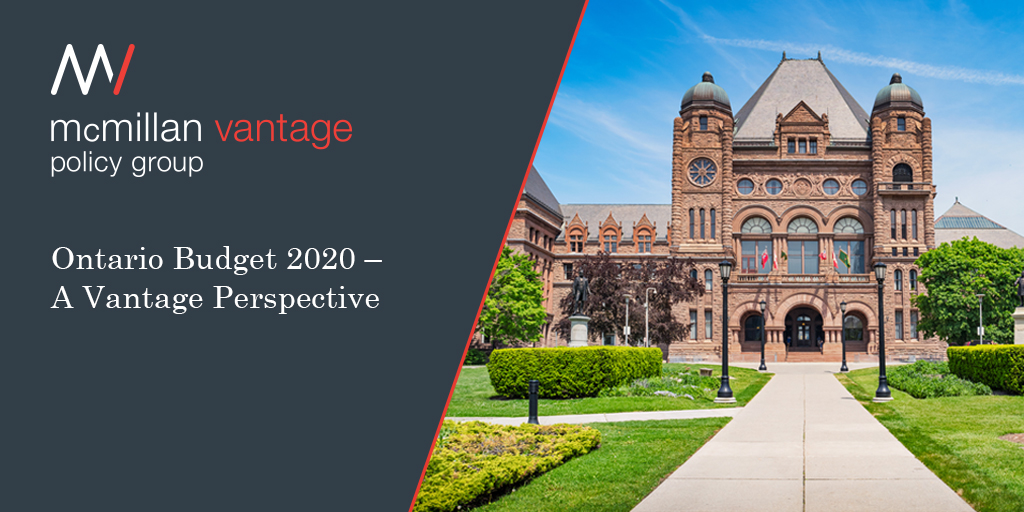GETTING BACK TO BUSINESS – BUT RED IS THE NEW BLACK
Ontario Finance Minister Rod Phillips has released his first Budget, Ontario’s Action Plan: Protect – Support – Recover. A decidedly “spend” budget, the fiscal outlook details about $187 billion in total spending this year with a projected record deficit of $38.5 billion. Written with input from 8,000 Ontarians, the 260-page budget opens the pocketbook across a wide range of areas, leaves room for continuing uncertainty, and emphasizes the importance of continuing the positive relationship that currently exists between the Provincial and Federal government.
(BANK)ROLLING WITH THE PUNCHES
Pre-2020, the Tories promised to balance the budget in five years. 2020 disagreed. Minister Phillips has however committed to get Ontario back on the budget calendar with another update expected by March 2021, which is slated to include a proposed path to balance (something that is missing from today’s document).
A unique feature of the 2020 budget is the acknowledgement of and forecasting flexibility included to accommodate the instability that remains in our communities and economy due to COVID-19. As Minister Phillips explains, “The range in private sector economic forecast… is twice as wide today as during the 2008 global financial crisis, and three times as wide as in normal times.” Just as COVID-19 infection rates forecasting is presented in varying slow-growth to fast-growth scenarios, so too is the economic and financial impact of COVID-19:

COSTLY COVID
A clear message of this Budget is the need to shore up our healthcare system, support long-term care facilities, and protect the most vulnerable. $45 billion (of which $30 billion has already been announced) has been dedicated to support health and the fight against COVID-19 over three years:
- Protect – Urgent COVID-19 Response ($15.2 Billion)
- Support – Support for People and Jobs ($13.5 Billion)
- Recover – Creating the Conditions for Growth ($4.8 Billion
- Improve Cash Flow for People and Businesses (11.3 Billion)
The government appears committed to implementing its promise to achieve four hours of direct care for every long-term care resident in Ontario by 2025, listing it as a “highlight” of the new COVID-19 funding but without further costing. Asked about the omission to cost the promise, the government said that it needed more time to consult with stakeholders and that “the funding is there and will be made available.”
Seniors can expect a Seniors’ Home Safety Tax Credit for the 2021 year, which will provide a 25% credit on eligible renovations up to $10,000. And families and parents will once again receive $200 per child under age 12 and $250 for children and youth with special needs age 21 and under.
BUSINESS AS UNUSUAL
As the province anticipates a 35% decline in corporate tax revenues, together with a decline in sales tax revenues, Premier Ford’s government is focusing on keeping Ontario “open for business” in a COVID-19 world. Commitments include:
- $300 million in relief for businesses in Stage 2 regions, where public health restrictions are necessary, or going forward, in areas categorized as “Control” or “Lockdown”
- Starting on January 1, 2021, medium-size and larger industrial and commercial employers would save about 14 and 16 per cent respectively, on average, on their electricity bills
- Reducing property taxes on job creators and levelling the playing field by lowering high Business Education Tax (BET) rates for over 200,000 employers, or 94 per cent of all business properties in Ontario, to a rate of 0.88 per cent.
- Responding to requests from local governments by proposing to provide municipalities with the ability to cut property tax for small businesses and a provincial commitment to consider matching these reductions. This would provide small businesses as much as $385 million in total municipal and provincial property tax relief by 2022-23, depending on municipal adoption.
And the more things change… the more the North needs reliable broadband internet. The budget commits an additional $680 million investment over the next four years in broadband infrastructure.
2021 – THE YEAR OF THE ONTARIO STAYCATION
Similar to what some other provinces have done, the Ontario government hopes to take advantage of travel lockdowns and border closures by promoting intraprovincial tourism. Calling 2021 the year of the Ontario staycation, the budget commits $150 million for “exploring ways” to “support” up to 20 per cent of tourism expenses to encourage Ontarians to hop around the province in the coming year. Personally, we’re looking forward to some government sponsored trips to Ontario’s world class wineries!
CLOSING THOUGHTS
While economic uncertainty remains, the document provides a clear range of fiscal outcomes. Clarity itself wasn’t enough to satisfy Opposition Leader Andrea Horwath, whose response was: “In his budget, Mr. Ford is throwing in the towel and telling people, families, & businesses, “You’re on your own.” Nothing for public health, seniors in understaffed care homes, kids packed into classrooms, & no help for saving jobs, small business, or workers without sick pay.” Liberal leader, Steven Del Duca, was similarly critical.
Finally, for those wondering, Minister Phillips sported a new pair of steel-toed work boots. It’s 2020. Better safe than sorry!
For help navigating the world of government or to receive McMillan Vantage’s tri-weekly COVID-19 updates, please contact info@mcmillanvantage.com.
